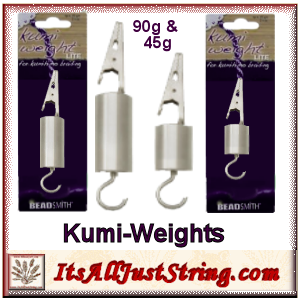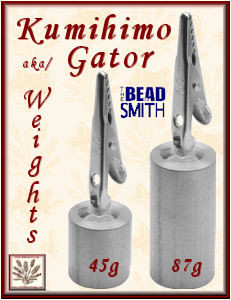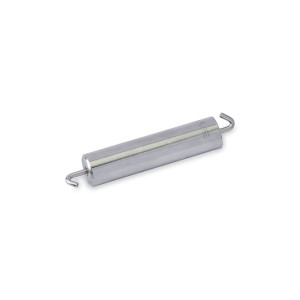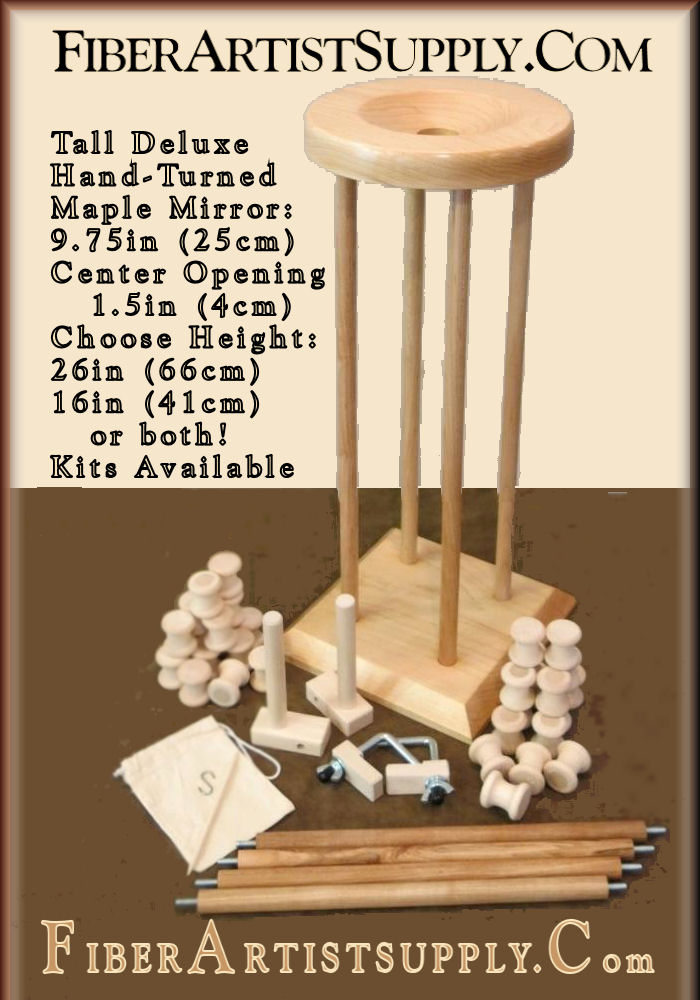» Currently browsing: Kumihimo
June 24th, 2015 at 22:21 pm »
Comments (3)This is NOT a commercial but it might sound like one.
More like a rant and ramble
And, I suspect I am about to annoy more than a few of those packaging kits for Beaded Braids – but since I do not buy kits, only “hear from my customers” and members of our facebook group about their misadventures – this really is not directed at individual or group of kit makers.
The most commonly used stringing material used for beaded braids is SuperLon (SLon). and you can read more about than you probably really want to know at:
The BeadSmith SuperLon (SLon) Cords and Threads
Happy Endings come from Better Beginnings and Good Better Beginnings start with Proper Planning
– enough with the alliteration
The most commonly given advice is to cut your cords 3 times longer than you want the finished braid.
And, that often works FOR ONE OF THE THOUSANDS OF BRAIDS that actually are Japanese and therefore considered Kumihimo.
If you are making the “round hard spiral” Japanese name Kongo Gumi (or Kongoh Gumi) then yes 3x might work. But if you value your time please consider….
One of the victims to paraphrase a friend of the
“Learn It On Monday,
Make a Tutorial On Tuesday
Teach It On Wednesday
Pack a “Kit” with the bare minimum on Thursday
is also the cause of the most grief to new braiders.
Running out of thread before your braid is done and then facing the choice of “taking it out” or going thru the agony of adding – something not always possible.
Remember this happens because Braiding is a FIBER ART and far too often otherwise competent Beadworkers do not understand the differences that really do matter.
Primary among the issues is takeup – this is the amount of thread that is used in each step used to form a woven or braided structure.
Takeup is affected by lots of factors, mostly human and unless that is considered in planning – all too often leads to the running out of cord.
CORD IS CHEAP – Seriously -SLon, at $2.90 per spool is $.083 per yard, So added cost is 67 cents –
What about the cost of shipping you say?
Using our sales records which shows the “SLon Only” order is rarely under 6 spools, that means you could make each cord about a yard longer for a whopping 88 cents.
Hate the idea of waste, well consider “thinking” about making those cords even longer and making matching earring “dangles”, or if you sell your work, a small sample that will the same braid in different beads or colors – or just pat yourself on the back because you now have 30 minutes or more to do something else that makes you happy.
“But I sell my work and have to keep my costs in line”
add the $1 to the price and pat yourself on the back because instead of wasting time unbraiding or otherwise fussing to make it work – because if you can’t see the value of your time, I can’t help you.
Tough Love Commentary – One can often learn more from the misadventures of another than you might think
Professional Crafter or Just love Braiding –
Isn’t your time and enjoyment worth more than maybe wasting $1 (retail)?
Now you know what I think, I’d love to hear your side.
February 9th, 2015 at 12:33 pm »
Comments (1)
With the recent announcement of the new accessory for Braiding on Disc – the Kumi-Handle – it seemed like a good idea to address another braiding aid, the Counterweight.
Although I have spent many hours working with a counterweight on a disc so I would understand its use; I do not usually use one. Just not how I learned.
Shown above is the recently released (Fall 2015) version offered by The BeadSmith and the one you will most readily find in my e-store. There are many DIY Solutions and eventually I may put together a list but for today…
So for today’s addition to the “department of general information” espoused by Shirley Berlin – some background on the the three currently commercially available versions of counterweight. It is possible I missed some, but here is what I can “Verify”

First produced in Canada by Jamie North’s partner – Kevin Swanson were the Gator Weights – but like many basically one man operations, with the explosion in braiding interest they apparently had some difficulty meeting demand. I know I often waited weeks for BeadSmith to get shipments and seem to always have the item in back order. These weigh approximately 45gm and 87gm and are slightly larger in diameter than the current Kumi-Weight.
About a year or so ago, the next addition to the counterweight field was put out by Beadalon. There version shown in the compatibility photo are intended for use with their spool knitter and for kumihimo.

The Beadalon hooks are not unlike some machine knitting weights I have use. I have never seen these in person so cannot speak from experience. Like all tools I am sure they will have fans. Still given how I feel about the Knitting Machine hooks I have like that is the look of their hook – I suspect even at their much lower price point, they might not be my preferred solution when a counterweight is required.
Within the product description on my e-shop is more of my thoughts – but I admit to being amused that the first thing TH said was “you won’t use those, the alligator clip will damage your fine threads” – not an issue for those only doing beaded braids with SLon cord.
This all need more thought, but I guess if I were not up for some DIY solutions, then I like that the most recent entry into the market has both the alligator clip and a hook (although I know the folks at BeadSmith have no clue how I will use it besides holding down the table cover on the picnic table.
What is important – is the consideration for those reliant on the counterweight if they will also be using the new Kumi-Handle. With that in mind, I will continue to work with my Handle, use the weight and share my findings.

Looking forward to your thoughts, comments, correction and divergent opinions on to counterweight or not.
p.s. still fact checking the timeline, I know I have the order correct, just need to check further on the exact dates.
February 7th, 2015 at 08:08 am »
Comments (2)Draft Last updated: 2015-Feb-08

Although this “timeline” is about Braiding on a Disc History, it would be remiss not to mention a little history of “beaded braids”
My goal in this article is to be as objective as possible – but I do have opinions and so some are going to leak thru. But yes, some of the links will lead you to pages at our online shop for Kumihimo “stuff” .
Braiding Disc & Square Plates are like any other tool – each of us will decide for the same and different reasons why we prefer one over the other. What may be worth mentioning while Kumihimo – The Art of Japanese Braiding dates back centuries – Braiding on Disc & Plate is a “modern” innovation and Beaded Braids are barely into its tweens as a mainstream craft technique.
Braiding on Disc and Plate is not the same as using a braiding stand – either the Marudai or a “flat top” or improvised equipment.
There are limited examples of beaded braids found in various museums in Japan and perhaps other places.
Until the late 1990’s when two things happened, most beaded braids where braided with traditional types of threads with beads sewn onto the body of the braid or used in tasseling finished work.
A few things happened that changed all that.
A Sample Swap on Compuserve with more than a dozen participants each prepared samples for the members of the study group and documented use of beads with braids. The shared experience created a niche of traditional braiders – using non-traditional materials.
 Inspired by the 1999 release of Jacqui Carey’s Beads & Braids, several “hot glass” beadmakers began to make, use and under duress, sell to their friends, some wonderful focals with large enough openings to allow them to be “threaded” onto traditional Fiber Only Braids.
Inspired by the 1999 release of Jacqui Carey’s Beads & Braids, several “hot glass” beadmakers began to make, use and under duress, sell to their friends, some wonderful focals with large enough openings to allow them to be “threaded” onto traditional Fiber Only Braids.

The first place I “heard” about “Braiding On A Card” was in Rodrick Owen’s Braids: 250 Patterns from Japan, Peru, & Beyond – this book was published in 1995. It was a bit later, during a class with Rodrick, at the Weaver’s Place in Baltimore, Rod said that he had been introduced to the idea of using a card when studying in Japan.
My impression at the time was that he viewed the cards (round and square) as a tool to understanding a braids structure and as a means to work some braids – particularly the Inca (Peruvian) braids originally worked without any sort of tool to be more easily made.
2000: Makiko Tada showed the first Foam Disc and Square Plates when she came to the US for the Handweaver’s Guild of America Conference.
Somewhere in this time range, Shirley Berlin first offered “the red book” Kumihimo On A Card – sparking more interest among the traditional braiders who wanted portability and a simpler solution to sampling color and textures.
The term “MobiDai” was first used by Makiko Tada and she confirmed in the original Kumihimo group (after Compuserve – before Yahoo) that she had “invented” the term to describe the ability of the disc to be “mobile” It is my understanding that “Mobidai” could be considered the intellectual property of the Hamanka company of Japan. With this in mind, I now only use it when referring to the Disc or Square Plate designed by Makiko Tada to be used with the instructions she has developed specific to this braiding tool. and of course her Comprehensive Treatise Braids: Vol VI & VII teaching braids for Disc and Square Plate are expanding the possibilities
For about 2 years only two distributors – Lacis & Helby Imports offered these products. Both distributors were already “involved” in supplying related books and tools in the US.
Beginning in about 1998 – several braiders began “translating” braids intended for the Marudai (Japanese styled braiding stand) to be comfortable worked on the Disc and later the Square Plate. That process continues today.
Somewhere in this time frame (late 1990’s – early 2000’s) Toner Crafts introduced its “weave wheel”. Because it was/is intended as a “Kid’s Craft” it was both smaller and less expensive. It is apparently still a viable product for Toner Crafts and proved there was/is a viable market for a smaller disc.
NOTE: maybe include the Craft & Hobby Association story & discussion with Jeanette Crews Designs about the craft
The combination of demand for a less expensive, but closer to Makiko Tada’s MobiDai Disc and Plates led to the production and introduction of the BeadSmith Disc beginning approximately 2002-2003.
Shortly after, under the influence various designs used in Owens: 250 and after speaking with some already involved in beaded braiding – BeadSmith introduced its version of the Square Plate –
Over the years, several of us have advocated to BeadSmith for changes – I personally have emails going back and forth with Larry Weiss since early 2000 (not quite the first of which was me sending him two discs “glued” together with a larger center opening to allow for fully beaded braids. I know there are others long active in the both the bead and fiber art communities who have provided input.
With the possible exception of the product first introduced at The National Needlework Association in (I think) 2005 or 2006 – With an unfortunate choice of name (I did say some opinion would slip in here )
Inspired by nagging from many and providing my sales data of the smaller Toner “Wheel” BeadSmith added the 4.25 inch size and some bulk options that was about all that happened until 2010 This pretty much where it has stayed.
In 2011, BeadSmith, working with Ann Dilker created a pamphlet showing some beaded braids and put together some finding sets packaged as “Kumihimo Findings” really stuff they were already offering to their independent retailers but it really seems to have proved to be the missing link.
Since 2011, it seems like every one with a toe in the bead and jewelry business is offering their own version of the Disc and some also the plate. Beadalon was likely the next to create its own private label disc about the same time they began producing their version of the Kumi-Weights in China for sale in the US – Another interesting story in itself.
Among the innovations is a 64 slot disc (not recommended), some smaller approximately (7.5cm to 8.5cm) = both okay with fine threads, but not comfortable use for even partially beaded braids without significantly enlarging the center opening and awkward to use with even the smaller size 1 & 1w Bob EEZ or embroidery floss cards, etc.
Keeping in mind personal preference – sometime in 2012 Sally Battis introduced her thicker disc – it was interesting recently to read her explanation for the beveled opening – I like the concept because it encourages beaded braiders to use the same technique traditionally taught by the master braiding teachers where braiding if often done a disc or plate relying on good technique to keep the tension adjusted rather than a weight. Again personal preference.
Most recent (announced to its Retailers in January 2015) BeadSmith has also introduced a thicker “double density” disc in both sizes with a significantly larger center opening – 35mm (approximately 1 3/8 inches). along with a “handle” that may prove to be useful for some.
…. To be continued – or revised or added to as time and energy allow
P.S. All with interest in beaded braiding are welcome to join the conversations at my small FaceBook group for Braids Beaded Kumihimo & More at:
https://www.facebook.com/groups/Beaded.Braids/
P.S. Jr: With thanks to Makiko Tada, Carolyn910, Larry Weiss,Janis Saunders,and Sally Battis for their assistance in assembling the facts and chronology. And to Hamanaka, BeadSmith and Beadalon for providing product to “confirm” the details. To Brad Colisomo of eXtremePara.com for his technical assistance in the development of the speciality disk for use with wire and paracord.
Other brands of Disc and Plate were purchased “at retail”.
October 12th, 2014 at 07:02 am »
Comments (0)Braid thinking out loud – there is a conversation in Kumihimo Beaded Braids that reminded me of a tip of sorts I had been meaning to share.
Although I do not have a smart phone, I do have an OLD Video Camera that I use exclusively to develop instructions and to determine where my execution of instructions is going horribly wrong.
Most recently I applied that to introductory Kumihimo Braids and more specfically what could be done to help those who want to move from disc to dai.
It has long seemed to me that the biggest & easiest issue to lose site of in the transition is so many do not understand that they are different. While I know some agree, it may well be we under estimate how long it is going to take for our frontal lobe to be convinced and as a result our progress and certainly our speed of execution is hindered.
So how to “fix” this. Flying in the face of conventional wisdom – creating a new Paradigm – and likely severely annoying a certain segment with the bead & braid world since it will mean rethinking and perhaps rewriting instructions – not to mention all those you tubes and free tutorials that (at least in my never humble opinion) hinder the growth of the braiders knowledge and skills.
For some time, my mantras were altered to start with “on this disc” and “on this dai” – AND I really needed to find out why I seemed to be having so much difficulty reacquiring the needed muscle memory as well as why I seemed to be losing it between projects.
In a effort to more objectively evaluate where I am going wrong, I used the video camera to see what I was doing and find the errors of my ways. The BFOO (blinding flash of obvious) there is no reason why a disc must be used with only one hand and in fact that is a detriment to the student to insist they should
It seems such a simple answer, using two hands regardless of the tool – disc or dai. Why not teach – to quote a wonderful Quaker lady a bit out of context – to start as we mean to go on. I have always found the reliance on numbers (and the tedious lines of instructions that creates) a hinderance. In braiding it is and should be about the movement and flow, not about moving eyes from page to disc to find the numbers.
I suppose this “thought” has been brewing for sometime and might just be why I “Suddenly” needed to work the introductory braids in Art of Kumihimo on a disc. A project that went more quickly because of using two hands as I would to have followed the information on a Marudai and when I then moved over to the marudai – was back up to speed within one full sequence of moves, instead of several inches of braid.
Further the self critique reminded me one of the reasons I like to braid is the use of two hands. now I deliberately use both hands prefer to use two hands with the disc is because when analyzing my own technique that there was a definite correlation between which tool I have been using more heavily and how long it took to get back the skill level previously enjoyed.
As always, since I already know what I think, I hope you will share you thoughts with me.
Now I need some guinea pigs to test my theory – hoping my braider friends will give it a try and let me know if it helps their transition from disc to dai.
August 2nd, 2014 at 12:00 pm »
Comments (2) In case you missed hearing about my present of the year, well maybe 2 years – this is about the FiberArtistSupply.com Deluxe Marudai kit –
In case you missed hearing about my present of the year, well maybe 2 years – this is about the FiberArtistSupply.com Deluxe Marudai kit –
Apologies in advance for gushing more than a little. Wheat (me) is an especially happy customer of FiberArtistSupply after recently receiving my “dream” Kumihimo equipment.
Tim Hale and his company, FiberArtistSupply have been supplying affordable quality tools to the yarn community since about 2007 – when I saw the photos of Tim and his family on Facebook, I was surprised that he is such a young guy – great news for the yarn users of the universe.
Since 2008 I have acquired more than a few of Tim’s Tools. Now, I am grateful that about the same time I decided it was time to follow the tradition of commissioning a marudai to meet my personal needs, Tim was just about ready to embark on a “redesign” of his Marudai and gave me the the opportunity to be among those providing input into the redesign.
I love traditional fiber as much as the quite recent practice of adding beads and other inclusion into the braid. (and, yes, have always know that what I was doing was braiding, but not exactly Kumhimio) My biggest wish was for a larger than usual center opening for the mirror than is now standard for Tim’s Tall Deluxe Marudai. My “kit” included both weights of tama – a minimum of 16 each and both sets of legs.
The 9.75 inch diameter mirror is excellent for my preferred 8-16 tama projects and adequate for the occasional mad foray into 24 tama braids. My goal is to eventually add another 8 as I use them as both tama and counterweight.
One of the issues with the taller “American” style of Marudai is that the traditional friction fit for the legs to allow easy set up and take down gets a bit wonky and wobbly. Add in the sometimes less than perfectly controlled movements for someone regaining muscle use and memory and Tim’s new screw in legs are a personal Godsend.
A compromise was needed related to the finishing. As a young woodworker Tim has some strong feelings about finishing. After listening – I had to agree that if the result was a more appropriate finish there was no reason not to take advantage of the kinds of finishes available today for the Marudai mirror.
So, after months of “engineer meets artisan” that included lots of me explaining WHY that detail was important in terms that would appeal to his sense of engineering and my desire for a reasonably traditional work and his educating me the nuances of creating a design for hand crafted production it finally arrived (early July) – I have been braiding happily away on samples for a future book “to test” the limits of my new toy and am not the only one amazed and amuzed to find nothing I would change or wish was different.
I am not sure if Tim will consider working on a custom project anytime soon (and I take full responsibility and hold him blameless) but am very pleased with the outcome of this one.
The only thing left on my braiding “I want” list are larger capacity bobbins and rumor has it Tim will be solving that problem for all very soon – well that and more time to braid and bead and weave, and most important of all ….
Enjoy The Making
Wheat
Oh, almost forgot – for ordering, pricing and availablity, visit FiberArtistSupply.com and check out the Kumihimo tools. Web Links Open In New Windows:
Kumihimo Tools at FiberArtistSupply
E Mail FiberArtSupply
Telephone: 847-530-0816
Email FiberArtistSupply
CC: Kumihimo Marudai Resource Links
CC: AllJustString.com Forum
FB: ItsAllJustString.com








 In case you missed hearing about my present of the year, well maybe 2 years – this is about the FiberArtistSupply.com Deluxe Marudai kit –
In case you missed hearing about my present of the year, well maybe 2 years – this is about the FiberArtistSupply.com Deluxe Marudai kit –